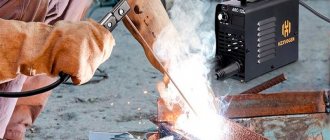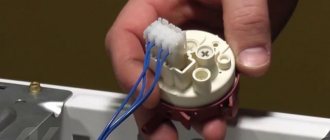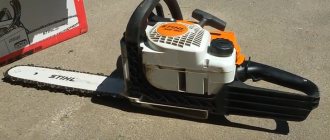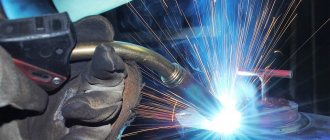In the spring we take the equipment out to the plot. Unfortunately, a situation often arises - the walk-behind tractor does not start. The reasons may be different.
For example, improper storage of equipment in winter: a cold and damp garage, exposure to precipitation, vapors of aggressive liquids, gases and particles of bulk materials.
It is also worth paying attention to the floor of the room where the walk-behind tractor is stored: the floor slabs must have no slopes.
The owner must quickly determine the cause of the failure and eliminate the malfunction of the walk-behind tractor.
Repair sequence
1. Check the integrity of the wire running from the button (On / OFF) on the walk-behind tractor control levers to the spark plug.
Checking the integrity of the wire
2. Remove the spark plug and clean the contact with sandpaper. Check the gap between the contacts.
Unscrew the spark plug
When I was assembling the walk-behind tractor and cutters, I left the keys in the box and forgot, so for a long time I looked for the ring wrench that was included in the kit.
Having unscrewed the spark plug, I discovered carbon deposits - apparently the quality of the gasoline is not very good.
3. Screw the spark plug back in.
The walk-behind tractor does not start - we bleed the fuel supply system
A murmur was heard in the tank. After this operation, the walk-behind tractor sneezed and started up.
I think that the fuel filter still needed to be washed, because... there may have been a blockage in it that was blocking sufficient fuel from entering the combustion chamber. In any case, at the moment the walk-behind tractor has started up and is working, and I hope you will also be able to start the walk-behind tractor if it doesn’t start for you. In my case, the walk-behind tractor did not start even after stripping the spark plug. So I opened the fuel wire flap and blew into it .
The easiest ways to revive a walk-behind tractor:
and can occur with both old and new equipment. In this case, you will need to troubleshoot the engine of the walk-behind tractor.
One of the possible reasons is the absence of a spark between the electrodes or its breakdown (breakdown). In this case, it is necessary to replace the spark plug with a new one.
If there is a spark, but the engine does not start, check the spark plug insulation. If the spark plug gets wet, the tip (or rather its insulator) may be faulty. Remove the screen and install a new tip.
A frequent failure of a walk-behind tractor is popping noises and the emission of flame from the muffler (the engine does not start). The reason for this may be deformation of the flywheel key. Replace it by disassembling the starter ratchet. Open the clutch housing, remove the flywheel, remove the old key, install a new one and tighten the housing.
If the starter cord is pulled out without effort when starting, the cylinder seal may be worn out or the gasket between the filter and carburetor may not be installed correctly. To resolve, replace the seals and check that they are properly secured.
The walk-behind tractor also stalls after winter or after a long period of inactivity. In this case, gasoline does not enter the carburetor. The cause of the malfunction is the locking needle. Sediment and tar formations accumulate near it and prevent it from opening when the engine starts.
Poor quality or inappropriate gasoline may cause engine malfunction. In this case, the spark becomes wet and requires replacement of the tip. If you notice an odor uncharacteristic of fuel, replace it. What if the walk-behind tractor starts poorly and stalls?
After starting, the walk-behind tractor periodically turns off with popping noises. Make sure the spark plug is dry. If a conductive substance appears on it, this may cause a lack of spark between the electrodes. The spark plug can be replaced with a new one or the old one cleaned. To do this, it is washed, blown and calcined.
The engine started for a few seconds and then died again. Check the permeability of the sump. If the faucet is clogged, it needs to be blown out and cleaned (using gasoline). Water may also get into the fuel. In this case, you need to drain it and fill in a new one.
How to start a walk-behind tractor and what to do if it stalls: we outline all the nuances
/ Motoblocks /
Reanimation of a walk-behind tractor after winter and the most common failures of walk-behind tractors.
I tried to start the walk-behind tractor after winter, but the walk-behind tractor would not start.
How to start a walk-behind tractor if it does not start can only be guessed at the beginning, because there may be several reasons:
— wire break; — there is not enough gasoline in the tank and it is not absorbed;
— the spark plug is dirty.
Why does the walk-behind tractor stall under load?
A fairly common problem is that the equipment stalls after 5 minutes of operation. Often the reason is a fuel supply failure and ignition problems.
If the equipment stalls during operation, you need to check how well the fuel is supplied:
- The candle is taken out and examined. It is overdried - this indicates a lack of fuel;
- There must be enough fuel in the gas tank for the normal functioning of the machine;
- The condition of the fuel valve is inspected. It may simply be blocked. Sometimes it is enough to open it for further use of the unit.
Possible reasons
Does the walk-behind tractor start and stall? Why is this happening? There may be several reasons why a motorcycle does not start when starting. These include:
- damage to the carburetor (in units with a gasoline engine);
- defective ignition and glow devices;
- low level of basic lubricant.
When unusual changes occur in the unit and its operation becomes unstable, the carburetor is checked first. In this essential unit, the formation of the fuel-air mixture (FA) and its dosage for supply to the cylinders of the internal combustion engine (ICE) take place. And if the jets become clogged , the fuel system becomes obstructed, causing the carburetor to lose its ability to guarantee engine starting.
In order to eliminate the defect, the fuel line is repaired, which involves a partial analysis of the carburetor, flushing the pump, and purging the nozzles through the fuel fitting. If the Neva walk-behind tractor does not start, the reasons may also be different. Sometimes the problem is hidden in a malfunction of the spark plugs, which play an important role in starting a carburetor internal combustion engine, or the glow plugs, which ensure the start of a diesel engine. If the igniter devices become wet, which happens due to fuel assemblies being thrown into them, the spark begins to disappear in them. In the absence of sparking, the fuel-air mixture is not ignited and, therefore, the engine cannot be started.
This problem can be solved in various ways:
- carry out minor repairs and replace non-working spark plugs with new ones;
- “burn” the flooded candles and use a flame to clean them of traces of fuel.
The equipment does not start due to a defect in the glow plugs.
In a diesel engine, fuel is ignited by contact with hot air, which is heated in the cylinder when compressed by the piston. This occurs without complications if the unit is already heated and the operating temperature in it is maintained by the heated walls of the cylinder. However, in cool weather, the engine is heated using incandescent devices, and if they break, it will not be possible to start the walk-behind tractor. If, upon inspection of a carburetor engine or diesel engine, no defective spark plugs were identified, but difficulties persist, and are also accompanied by popping noises in the muffler, it is necessary to check the functionality of absolutely all devices responsible for the flammability of fuel. A defect in them may also be a reason that the walk-behind tractor does not start. It is more correct to carry out diagnostics in a service center, where specialists will find the cause of the damage and carry out professional restoration.
The walk-behind tractor starts and stalls - faults, repairs, video
The “heart” of any gasoline-powered vehicle is the engine. Walk-behind tractors are no exception to this. Their motor part creates a working stroke, power potential, and declared productivity, which together make it possible to perform certain agricultural operations.
But often it is this working node that is the most vulnerable. Low-quality fuel, severe overloads, lack of regular diagnostics and many other reasons cause serious malfunctions, the timely detection and repair of which will determine its further performance. This article will be devoted to what types of breakdowns are most often characteristic of walk-behind tractor engines, and which ones can be diagnosed and fixed at home.
The walk-behind tractor starts and stalls: causes of malfunction and mechanisms for eliminating them
Owners of either brand new or used motor cultivators are not insured against a situation where the walk-behind tractor starts but immediately stalls at idle.
It can be caused by a number of factors:
- problems in the ignition system:
- loose or broken electrical contacts;
- spark plug malfunction. They can be installed only after unscrewing and external inspection. If the candle:
- dry - the cause of the malfunction lies in the carburetor, where gasoline is not supplied. It may occur due to clogging of its filter or a separate jet;
- wet - the engine does not develop speed due to an excess of fuel;
- covered with soot - the fact of its failure, which may result in the failure of an ignition spark to form. Testing with electrodes will help you finally verify this;
- after replacing or cleaning the spark plug, the electronics are examined - the integrity of the connections and the wires themselves, which may need repair due to strong vibration;
- shortage or poor quality of fuel . Often the engine does not gain speed due to an incorrectly prepared fuel mixture or debris in the carburetor. In this case, the repair begins with removing it from the walk-behind tractor body and cleaning it from dirt particles. At the same time, they change the fuel, after draining the old one and washing the fuel tank and supply hoses.
- Another reason that the walk-behind tractor starts up and immediately stalls, related to gasoline, may be depressurization of the gas tank itself. Very often this is observed after a long period of inactivity (for example, after winter), when the walk-behind tractor has not been used for a long time and has been stored with gross violations. After repairing or replacing the entire fuel tank, the functionality of the device is usually restored;
- cool weather, which often causes diesel equipment to stall. Therefore, in early spring, experts advise turning on the walk-behind tractor only after pouring hot water into the radiator;
- gearbox malfunction. The fact that the cultivator does not develop speed and stalls at idle is indicated by a characteristic knocking noise from the gearbox, which occurs against the background of a lack of lubricant.
Preparing the walk-behind tractor for start-up
Difficulties with starting the engine can appear not only in used walk-behind tractors and cultivators, but also in new ones just purchased at the shopping center.
For this reason, before starting a mini-tractor for the first time, you should read its instructions, then carefully examine all connections and, of course, check the oil level in the internal combustion engine. You should study the annotation compiled by the manufacturer in order to find out what operating speed the engine has: four-stroke or two-stroke. This is important to understand, since modifications with a two-stroke engine (like the Mole cultivator) require a special combustible mixture, consisting of a mixture of fuel and oil in a special proportion.
Due to the mismatch of fuel, the special equipment will make noise, and the spark plugs and fuel line may also be damaged, which can lead to fuel pump failure, and this is a direct path to expensive repairs at a service station. determine whether the fuel is suitable for the motorcycle by the smoke that appears. If the quality of the fuel is poor, it will have a white tone, as happens when the car is tilted too much.
Fuel quality is also important for a diesel walk-behind tractor. It does not start in winter - or it starts, but soon freezes - if summer diesel fuel is poured into its engine, since at low temperatures it begins to thicken and clog the fuel line.
The start-up of motor vehicles both in the summer and in the winter must be carried out in the established order. For example, to start a Krot brand motor cultivator, the following procedure is carried out:
- open the gas tap;
- set the suction motor to the “Choke” state;
- turn off the ignition and turn the engine several times with a manual starter;
- start the motor again and move the motor to the “Run” state.
Conditions often arise when the power apparatus starts easily, but freezes after a couple of seconds. In this case, you should check the permeability of the sump. If the reason is that the tap is clogged, then it is cleaned with gasoline.
Starting a motorcycle with a diesel engine will be somewhat more difficult. Starting a diesel engine begins with “de-airing” the fuel path, that is, by ridding it of air accumulations. For this:
- open the fuel supply valve;
- untwist the connections of the outlet channel until fuel appears;
- twist the connections and blow through all the nozzles.
If after the operations the motor does not function properly, and the special equipment begins to smoke, then the reason is the old lubricant, and it must be completely changed.
The unit does not start due to insufficient volume of oil fluid, so do not forget to control this parameter. Starting a motor cultivator after winter or prolonged downtime also has its own nuances. In order to bring the unit into working position, perform the following manipulations:
- open the gas tap;
- check whether the power is turned on;
- check the presence of lubricant;
- let the gas reach about half way.
Before putting the motorcycle into operation, all connections are checked, including transmission sections, clutch, starting mechanisms, and, if necessary, they are adjusted.
Device and main characteristics
The MB 2 device is very popular these days; it is simply irreplaceable in agriculture. This line of “Compact” walk-behind tractors is produced under the same brand, but has a difference in the engine:
- “Neva” with index 2K is equipped with a domestically produced motor, so the price of such a device is much lower than that of foreign analogues;
- the second 2B abbreviation indicates that this mini-tractor has an imported engine;
- the abbreviation 2C denotes professional elements in the structure of the apparatus that are used for cultivating the land.
The characteristics of the motor should be taken into account when choosing a unit in order to successfully cultivate the required amount of land, be it tens of acres of land or a much larger area. The design of the unit is the following system.
- The gear-chain type gearbox is located in a specialized case made of aluminum. Its main task is the high speed of the unit. The device has four forward gears and a pair of reverse gears to carry out the revolution. Its maximum speed is 12 kilometers per hour, so this device can even be used for transporting goods.
- To start this small tractor, a motor with a starter is used.
- The frame, which acts as a support, has special fasteners, which are located at the back and front and are used as devices for working in weight.
- There are certain levers on the steering device that are used during operation of the mini-tractor.
- The V-belt type transmission produces the transmission of the clutch assembly from a pulley, a special lever and a V-belt.
- The unit is compact and lightweight, even the very heavy version weighs only 97 kilograms. This device can be easily transported anywhere, even in a regular car.
The unit with the abbreviation MB 2 has enormous capabilities; it can perform a large amount of work in agriculture, such as: plowing, cultivation, planting seeds, the process of hilling and weeding between rows and harvesting. Neva produces all this using a large selection of equipment that is used in mounted form, as well as thanks to a large number of innovations. The technical features are presented by the Neva MB 2 apparatus as follows:
- It is recommended to refuel the unit only with gasoline;
- hardware power 7.6 l. With.;
- Russian DM-1K engine, a 4-stroke engine with a single cylinder;
- there is an engine with a volume of 317 cubic meters;
- the engine is started manually;
- air and liquid cooling;
- tank volume 2.8 l;
- gear, chain editor;
- fuel consumption is 2.9 liters per hour.
Other characteristic features are:
- during cultivation the grip is 160 cm;
- the depth of the earthen area is 16-26 cm;
- tractor length 1750 mm, height 1350 mm, width 630 mm;
- This mini-tractor can handle about twelve acres per hour.
Starting a gasoline and diesel unit
The equipment is equipped with gasoline or diesel engines. starting a diesel walk-behind tractor and a gasoline machine.
For this reason, it is necessary to analyze the factors due to which the unit does not start for each specific type of engine. Before purchasing a walk-behind tractor , special equipment is prepared. It is necessary to make sure that absolutely all elements are present and to make sure that the mechanisms are securely fastened.
Mechanisms often refuse to work after winter. A long break becomes a prerequisite for the occurrence of problems in the walk-behind tractor systems. Storing in a cool and humid area will cause the following problems:
- oxidation of contacts;
- violation of wiring insulation;
- watering of fuel and oil;
- clogged carburetor jets.
Before starting a new walk-behind tractor, absolutely all connections, clutch cable, reverse and gas are checked.
Do not turn on the device if there are clamps or twisting of the harness threads. During the first start-up, be sure to check the oil level in the crankcase. Lack of lubrication will damage the piston group. The crankshaft spins up to 1400 revolutions per minute at idle. It only takes a couple of seconds to create a scuff mark on the cylinder plane.
Old oil can cause the engine to not run. At the same time, the walk-behind tractor emits white exhaust gases. This begs for an absolute oil change.
It should be taken into account that the mini-tractor does not start easily if there is not enough oil. Keep an eye on this parameter before starting a carburetor and diesel walk-behind tractor. In some modifications, protection is determined by a low level. The device blocks startup and the unit freezes.
It should be remembered that any type of engine requires a specific brand of gasoline. For a two-stroke engine, fuel is prepared separately. The fuel mixture consists of fuel and oil. The number of ingredients is kept in strict balance.
Why does the walk-behind tractor shoot into the muffler?
Often, when working with an agricultural implement, loud, uncharacteristic sounds are clearly audible from its muffler. At the same time, the walk-behind tractor also smokes heavily and stalls. To be able to fix a problem with your own hands, you first need to determine its essence.
Most often, a walk-behind tractor shoots into the muffler due to a number of the following problems:
- There is an excess of engine oil in the fuel mixture - in this case, you need to drain the remaining fuel, wash the fuel pump and hoses, and fill in new fuel with less oil;
- Incorrectly set ignition - if the mechanism works late, this leads to the appearance of atypical shots, which are clearly audible in the muffler area. In such a situation, you should immediately set the correct gap between the electrodes of the walk-behind tractor's ignition system;
- Incomplete combustion of fuel in the engine cylinder. Repairing a walk-behind tractor engine in this case involves disassembling the piston group, thoroughly washing and drying the engine cylinder, as well as adjusting the walk-behind tractor carburetor.
Repairing all of the above breakdowns does not require special skills or extensive experience. The most important thing is to act strictly according to the operating instructions for the agricultural unit.
Mechanism repair
Starting a diesel engine after purchase can be difficult.
The problem is that air gets into the fuel supply system. If cranking for a long time (with the starter) fails to start, it is necessary to release the air plugs. To do this, open the supply valve and unscrew the connections along the channels. The final point of purging is the injectors. In order for an internal combustion engine to start , several conditions must be met. Let's list them in order:
- preparation of the mixture;
- delivery of fuel to the cylinder;
- ignition of the mixture;
- release of gases.
Fulfillment of the mentioned conditions ensures the start of any engine.
The walk-behind tractor does not develop speed: the reason
Two-wheeled, mechanical devices of this type, such as a walk-behind tractor or cultivator, are in great demand among farmers, gardeners and cultivators. They minimize human physical labor and help cultivate the soil, remove grass or snow, and transport small loads.
Like any other mechanical unit, a walk-behind tractor can fail and cause a lot of inconvenience to the owner. Careful care of the device and following all operating rules specified in the instructions for use can minimize the likelihood of breakdown. However, no matter how high-quality the walk-behind tractor is, there are parts and elements that become unusable before others. And such an element is the engine.
The walk-behind tractor fails for certain reasons
Why does it stall under load?
“The walk-behind tractor stalled during operation” - you can often hear from the mouths of users of these units. The problem may be a malfunction of the fuel supply system or ignition system.
In the first case, check the spark plug. If it is not wet, it means that fuel liquid does not enter the engine cylinder.
Important! Pay attention to the fuel level. The problem could also be with the fuel valve if it is tight.
Difficulty starting
Difficulties during startup indicate a malfunction of components and elements. The success of repair work depends on the accuracy of the diagnostics. If deficiencies are found, they repair the diesel walk-behind tractor. Service and minor repairs can be carried out on your own. You will need a set of keys, a locksmith mechanism and skillful hands.
At the fuel preparation stage, the following incidents are likely:
- a lightweight filter does not let air in;
- the hole in the tank lid is boarded up;
- the fuel supply channel is clogged;
- The carburetor broke down.
After a series of unsuccessful starts, it is advisable to unscrew the spark plug.
The working part can be filled with fuel. In this case, we dry the element, then pump the cylinder through the hole. We twist the candle and start it again. If the candle is dry, it means that fuel is not entering the combustion chamber. Let us perform several operations one by one to restore the supply system:
- drain old gasoline;
- wash the tank;
- clean the special filter from dirt;
- clean the fuel supply hose;
- clean the carburetor jets;
- fill the tank with the cleanest fuel;
- open the tap;
- Clean the breathing channel in the tire.
Ignition system malfunctions
The engine will not start if there is a breakdown in the ignition system.
Why is this happening? Sources of interruption may be the generator, high-voltage cable, cap and spark plug. An external inspection is necessary to check the cleanliness of the ignition system elements. Dirt and moisture serve as a prerequisite for high force breakdown on the body. A lack of spark occurs when the cap does not make proper contact with the main electrode of the spark plug. A weak spark indicates poor spark plug performance. The gap and type of electrodes should be checked. The gap is usually checked with a feeler gauge. As a rule, the figure is 0.8 millimeters. If necessary, remove fumes from metal elements and insulators. It is recommended to change the spark plug.
The condition of the piston category elements affects the readiness of the engine as a whole. They operate in difficult circumstances. Under loading, the rubbing surfaces heat up. The cylinder, valve and rings are responsible for a significant indicator - compression. A low compression ratio in the cylinder will indicate replacement of elements.
It is also necessary to check the intake and exhaust valves. They should be close to the saddles. The muffler is the last point on the gas path. Over time, combustion products are deposited in the walls of the muffler, and the engine freezes. For a standard passage of exhaust gases, it is necessary to clean the walls of carbon deposits from time to time.
Buy gasoline for walk-behind tractors at gas stations. The operating period of the machines directly depends on the properties of the fuel. There is no need to start the walk-behind tractor on bad fuel.
Why the walk-behind tractor won't start - let's understand the reasons
Before the start of the season, both gasoline and diesel walk-behind tractors need preparation. To do this, the owner of the unit must make sure that the design of the unit contains all the parts necessary for operation, and each of them “sits” tightly in its normal place.
Often, many walk-behind tractors equipped with a Subaru engine or engines of other well-known brands refuse to work after a long winter period of inactivity. At the same time, incorrectly chosen storage conditions for an agricultural machine also have an effect - if it has been standing in a cold, damp room, then, most likely, it will not start before the start of spring work. This is due to a number of malfunctions:
- Oxidation of contacts in electrical wiring;
- Violation of the integrity of the wiring insulation;
- Watering of oil and fuel;
- Accumulation of debris in the carburetor jets.
Before starting a walk-behind tractor, its owner must carefully inspect all the connections in the design of the unit. You need to check the movement of the throttle, reverse and clutch cables - it should be soft. If during inspection you find clamps or twisted cables, then you cannot start the walk-behind tractor.
Before starting the walk-behind tractor for the first time, you should check the oil level inside the crankcase. If the lubricant is missing, this will lead to severe damage to the piston group. Judge for yourself: at a crankshaft rotation speed of 1400 rpm, a split second will be enough for it to form several burrs on the surface of the cylinder.
Oil left over for the winter is one of the main reasons for unstable operation of the unit’s motor. It is quite simple to make sure that the walk-behind tractor is difficult to start for this very reason - after starting, white smoke will pour out of the exhaust pipe of the machine for a few seconds, after which the unit will stall.
Do not forget that both diesel and gasoline walk-behind tractors have difficulty starting due to insufficient oil. Some models of units are equipped with low level protection; owners of other machines should independently monitor the volume of oil inside the tank.
Another important factor is the gasoline you use to refuel your walk-behind tractor. If you regularly fill up with fuel of a different brand than that recommended by the car manufacturer, this may also cause the car to not start.
Why is a diesel walk-behind tractor difficult to start?
| Cause | Solution |
| Low room temperature | You need to pour hot water (not boiling water) into the radiator itself |
| Nozzle clogged | The injector needs to be replaced or cleaned. |
| Fuel is frozen | It is advisable to heat it up or even replace it with a better and fresher one. |
| Carburetor contamination | It should be removed, cleaned and adjusted |
| Muffler clogged with combustion products | The owner must disassemble the muffler, inspect it, wash it in fuel and clean it with a special scraper |
| Low injection pressure | Adjust pressure to normal level |
| The engine turns over too quickly and easily with the starter |
- The valve stem is stuck;
- The piston rings are completely worn out.
- Be sure to remove the valve and wash it thoroughly;
- It is important to replace the specified spare parts with diesel walk-behind tractors.
In any case, you should carefully study the instructions and follow the specified rules, because such care for your “assistant” can improve productivity and save time for the owner, who in the near future will no longer be involved in repair work and purchasing additional parts.
Despite all the reliability of modern walk-behind tractors, sooner or later they fail, which makes it impossible to start the unit and continue working on the site. We suggest studying the most common breakdowns of agricultural machines, as well as methods for fixing them yourself.
Do-it-yourself troubleshooting
Success in self-repairing a walk-behind tractor largely depends on how correctly you diagnose the unit. The reasons that the walk-behind tractor does not start may be hidden in the following:
- Due to blockages, air does not pass through the air filter;
- The hole in the fuel tank cap is clogged;
- Debris has accumulated in the fuel supply channels;
- Carburetor failure.
Each of these malfunctions is quite easy and quick to fix with your own hands. If this is not the cause of the breakdown, and the unit still does not start, then you should unscrew the spark plug and check for oil stains on it. If you find oil or thick carbon deposits on the spark plug, the part needs to be cleaned and dried. In addition, the cylinder of the walk-behind tractor will also need drying - to do this, you need to sharply pull out the starter cable several times.
It is often difficult to start a walk-behind tractor due to the lack of fuel in the combustion chamber. In this case, the candle will be completely dry. If this is the cause of the breakdown, then the following measures will need to be taken:
- Completely drain the old fuel;
- Thoroughly rinse the fuel tank;
- Clean the air filter from blockages;
- Blow out the fuel supply hose with compressed air;
- Blow out the carburetor jets;
- Fill the tank with fresh gasoline;
- Open the fuel tap;
- Blow out the breathing passage inside the fuel tank cap.
Before restarting, you will need to manually prime the fuel by pressing the fuel pump primer several times. After starting the engine, be sure to give it time to warm up, after which you can start working with the walk-behind tractor.
If all of the above steps did not help, and the walk-behind tractor still does not start, then check the intake and exhaust valves - if they do not fit tightly to the seats, the parts will need to be adjusted by turning the corresponding screws clockwise.
Also, if the walk-behind tractor does not start, we advise you to pay attention to its muffler - after prolonged operation, carbon deposits accumulate on its walls, which must be regularly removed using compressed air.
Let's figure out why the walk-behind tractor stalls
When your hitherto trouble-free walk-behind tractor begins to act up, it is very annoying. It’s doubly annoying when this happens in a situation where there’s a lot of work and without a walk-behind tractor, it’s like without hands. It seems to start normally, but as soon as you give it a load, it immediately sneezes and stalls. What is the reason for such “betrayal”?
The main problems of the walk-behind tractor engine
It is impossible to give an answer to such a seemingly simple question offhand. There are many reasons why the walk-behind tractor becomes capricious and stalls during operation. Conventionally, they can be divided into several groups:
- problems with fuel supply;
- malfunction of the engine starting system;
- control and automation malfunctions;
- problems with the muffler, cooling, etc.
If you notice problems in the operation of the walk-behind tractor, then the main thing you must understand is that there are problems that you can easily fix with your own hands, even if you are not particularly versed in technology, and there are situations when it is impossible to do without a competent specialist and appropriate equipment. The most important task for you, as the owner, is to quickly and correctly determine why your walk-behind tractor is stalling and make the right decision.
Fuel supply problems
If during operation the walk-behind tractor stalls and does not start again, then most likely the problem is in the engine or in the starting system. The first thing to do in this situation is to carefully inspect the spark plugs. Dry spark plugs mean that fuel does not have access to the engine cylinders.
In such a situation, first of all, check the presence of gasoline in the tank. It is possible that due to your forgetfulness, the walk-behind tractor has used up all the gasoline, and it simply needs to be refueled for further work. If everything is fine with gasoline, check the fuel valve - it may be closed.
There is nothing complicated in this situation either - just open the tap and the engine will come to life again. It also often happens that during operation the walk-behind tractor stalls due to a strong roll. You need to place it horizontally.
If the engine starts in this position, it means that there is little gasoline in the gas tank and when tilted it simply does not come out of the gas tank; you need to refuel.
The next thing that often happens is that the drain hole in the gas tank plug becomes clogged. You need to clean it, and the problem will be solved. It often happens that some kind of rubbish has gotten into the fuel system, especially considering the quality of gasoline today. In this case, you need to remove the fuel tap, drain the gasoline from the tank and rinse everything thoroughly, and then disconnect the connecting hose from the carburetor and thoroughly blow it out.
Starting system malfunctions
If during inspection the spark plugs turn out to be wet, but the engine does not start, then detecting the malfunction will be much more difficult:
- the ignition system may fail;
- due to depressurization of connections, air leaks may occur;
- the air damper in the carburetor may not be closed enough;
- carburetor failure.
A failure of the ignition system is an unpleasant moment, but you should not panic and immediately call a specialist. First, remove and inspect the spark plug. If you find carbon deposits on it, clean it with sandpaper, rinse it with gasoline and let it dry completely. Very often, after such a procedure, the engine begins to work normally.
If the engine still won't start and you feel competent, check the gap between the electrodes. The required value is indicated in the manufacturer's instructions, but due to constant vibration during operation, it may change, and the walk-behind tractor may stall while driving. Adjust the gap to the desired value by bending the side electrode.
It will not be possible to deal with other problems of the ignition system right away. If the insulators of spark plugs or electrical wiring are burnt out, they need to be replaced. You can also short the “STOP” button to ground, and until the short circuit is eliminated, the engine will not start. Also, the reason that the engine does not start may be a violation of the contacts in the spark plug brackets or a violation of the gap between the magnetic shoe and the starter. Finally, the starter itself may be damaged and will need to be replaced.
Another common reason why a walk-behind tractor engine “chokes” or stalls under load is air leaks. If this occurs due to depressurization of the carburetor connections, then you must first tighten the spark plugs and tighten the mounting bolts, and then check and, if necessary, replace the gaskets. The engine will “choke” even when the carburetor air damper is open. To fix the problem, it needs to be adjusted, making sure that it moves freely without distortions or jamming.
If the walk-behind tractor does not gain power normally, it is worth checking its muffler. Over time, fuel combustion products clog the muffler, forming a thick layer of soot on its walls, so it needs to be cleaned periodically. To do this, the muffler must be removed, plugging the outlet hole with a clean rag, washed first in gasoline, then cleaned of carbon deposits by washing with detergents, and finally dried with a hairdryer.
Sometimes the walk-behind tractor stalls during operation due to simple overheating. If, with the throttle fully open, you press the throttle, and the engine, instead of accelerating, loses speed, then this is a clear sign of overheating. The walk-behind tractor must be stopped and allowed to cool completely, and then started again.
This is not the entire list of reasons why your recently perfectly serviceable walk-behind tractor may stall even under light load. Almost all components of the walk-behind tractor are subject to significant loads during operation, so minor malfunctions and breakdowns are not uncommon.
Therefore, if you discover that there is something wrong with the walk-behind tractor: extraneous noise, twitching, strong vibration, etc. - Turn off the engine immediately. And only after the engine has cooled down can you begin troubleshooting. But this is a topic for another conversation.
Interesting article? Share with your friends!
Source: https://instrumenty.info/publikatsii/publikatsii-dlya-dachnikov/pochemu-glohnet-motoblok.html
There is no spark on the walk-behind tractor - let’s look into the problem
Another common reason that a walk-behind tractor will not start is due to a problem with the unit’s ignition system.
Faults may be hidden in the cap, magneto, spark plug or high-voltage wire of an agricultural machine. When inspecting the ignition system, first of all you need to carefully check each part for blockages. If the spark is lost, the reason for this is often moisture or dirt getting on the elements of the ignition system. Also, often an agricultural machine does not start due to the inability to form a spark - the reason for this is poor contact between the central electrode and the spark plug cap.
If you do not find dirt or moisture in the ignition system, and the walk-behind tractor does not start, then be sure to check the integrity of the electrodes and the gap between them. As a rule, a special probe is used for this. Ideally, the gap should be 0.8 mm. If necessary, remove carbon deposits from the insulator and metal elements of the ignition system.
Checking equipment before launch
Depending on its basic configuration, the cultivator can be equipped with a gasoline or diesel internal combustion engine. There are certain differences between these motors. Consequently, the reasons why the cultivator does not start may also be different.
Before starting the equipment, it must be prepared. During this, you should carefully inspect all working mechanisms and make sure that their fastenings are secure. Sometimes nodes refuse to work simply due to prolonged downtime. This is due to improper storage conditions. For example, if the equipment is kept in damp and cold rooms.
In these cases, the following malfunctions may occur:
- oxidation of ignition system contacts;
- loss of properties of fuel and oil;
- violation of electrical wiring insulation;
- clogged carburetor jets.
Before starting a new cultivator for the first time, you need to carefully check all connections, gas and reverse functions, as well as the integrity of the clutch cable. The latter should move smoothly, and during startup the operator should not make much effort. The engine cannot be started if the cable is twisted or caught between parts.
Starting must be carried out with a sufficient amount of oil in the engine crankcase. In the absence of lubrication, the piston group of the equipment will be subject to increased wear. In most models, the crankshaft is capable of rotating at speeds up to 1500 rpm. Thus, a few seconds are enough for the cylinder to partially deform.
To partially avoid problems with starting the engine, you need to drain the old fuel and oil after each use of the equipment. If you do not do this, the gasoline will gradually succumb to watering. The same goes for motor oil.
When preparing the cultivator, special attention is paid to the condition of the electrical wiring. If its insulation has been damaged, the wires will need to be removed and cleaned. When restarted, the equipment should start.
Malfunctions of walk-behind tractors - why they stall, do-it-yourself repairs
The walk-behind tractor is a useful household unit that greatly simplifies land and house work. Like any other equipment, units can break down. But it is quite possible to repair a walk-behind tractor engine yourself, following simple recommendations.
Why does the walk-behind tractor start and stall?
If the equipment starts and immediately stalls, this may indicate the following problems:
- There may be a large distance between the electrodes, problems with contacts in the electronics, or the spark plug may be dirty. First, the candle is cleaned. Then the integrity of the wires is checked. The normal distance between the electrodes is set;
- The carburetor may become dirty, too little fuel is supplied. Sometimes it is necessary to change the fuel and reduce the amount of oil. The carburetor is dismantled, disassembled and thoroughly cleaned;
- If the unit does not pick up speed, this indicates a lack of fuel. Gasoline may simply spill. The defect must be eliminated or the fuel tank replaced;
- The walk-behind tractor does not develop speed when the gearbox breaks down. This is indicated by the presence of extraneous sound from the gearbox. The malfunction can be eliminated by replacing the oil that lubricates the components.
Why does a walk-behind tractor engine have difficulty starting when hot?
The equipment may stall when heated. This problem can be resolved relatively easily. This is often caused by excess air being supplied to the carburetor. It is mixed with gasoline and motor oil and acts as a carburetor coolant. So the temperature of the latter is much lower than the temperature of the walk-behind tractor engine.
To fix the problem, you need to follow a certain algorithm. It is important to start the engine. To do this, perform the following steps:
- When starting the engine, the throttle trigger is squeezed halfway;
- You should not regularly press the gas trigger, as this may cause the engine to flood;
- After starting the engine with the throttle trigger pressed halfway, you need to throttle it thoroughly. Afterwards you can continue working.
Simple actions will prevent an increase in the load on a heated engine; the main elements and systems are not subject to increased wear. The listed methods will allow you to eliminate any malfunctions with the unit. They are equally effective for owners of the following brands: Agro, Honda, Neva, Cascade.
Source: https://sadovaja-tehnika.com/motobloki/neispravnosti/
How to start a cultivator - the correct procedure
Often, household equipment does not start because its owner does not know the correct procedure for starting. In this case, you need to carefully re-read the cultivator operating manual. If it is not there, then you need to adhere to the algorithm that is suitable for most models.
To start the motor cultivator, you need to perform the following steps:
- First you need to move the fuel valve lever to the “Open” position;
- Then you need to close the throttle valve;
- After this, the ignition lever will need to be moved to the “Open” position;
- Next, the gas lever needs to be moved slightly to the left;
- Then you need to smoothly pull the starter lever until resistance is felt. Immediately after this, the lever must be returned to its original position and pulled sharply;
- The cultivator engine will start. You need to wait about 2 minutes until the engine warms up. As the internal combustion engine warms up, you should gradually open the throttle valve;
- You can adjust the optimal engine speed using the throttle position adjustment lever.
After completing all of the above steps, the farmer can start using the cultivator. To stop the engine, move the fuel valve lever to the “Off” position.
Why won't the cultivator start?
The main reason why equipment does not start is the presence of old oil in the crankcase. This will be indicated by white smoke emanating from the exhaust system. To solve this problem, you will need to completely drain the old oil and clean the carburetor. After this, you need to fill in new lubricant.
Often the cultivator does not start due to lack of oil in the crankcase. Before starting, the farmer must check the amount of composition inside the tank using a dipstick. Sometimes cultivators are equipped with special protection that automatically triggers when there is a lack of oil. In these cases, a special sensor issues a command to block the start, causing the engine to instantly stall.
When using equipment, you need to remember that each cultivator model runs on one specific brand of gasoline. To refuel a 2-stroke internal combustion engine, you need to prepare the fuel mixture in advance. In this case, you should adhere to the proportions specified in the equipment operating manual.
To extend the life of the cultivator, only clean fuel should be used to refuel it. The working life of the piston group of the engine and the carburetor of the equipment depends on the presence of harmful impurities in it.
Diesel engine repair
The engine becomes faulty most likely due to its improper operation and non-compliance with the procedure and timing of work. After all, few people change the oil in the unit according to the standards, and this procedure should be carried out after the walk-behind tractor has run 7,500 km. Since the fuel contains a high concentration of sulfur, the oil quickly oxidizes and loses its properties. Accordingly, all this affects the operation of the piston group. But this is, of course, one of many possible reasons for the failure of this part. There are 2 types of engine malfunction: either it does not start at all, or it does not work satisfactorily.











